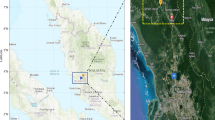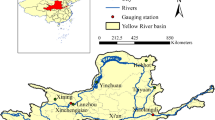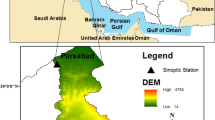Abstract
Prediction of long-term rainfall patterns is a highly challenging task in the hydrological field due to random nature of rainfall events. The contribution of monthly rainfall is important in agriculture and hydrological tasks. This paper proposes two data-driven models, namely biogeography-based extreme learning machine (BBO-ELM) and deep neural network (DNN), to predict one, two, and three month-ahead rainfall over India (All-India and six other homogeneous regions). Three other data-driven models called ELM, genetic algorithm (GA)-based ELM, and particle swarm optimization (PSO)-based ELM are used to compare the performance of the proposed models. Firstly, partial autocorrelation function (PACF) is applied in all datasets to select the optimal number of lags for input to the models. Secondly, the wavelet-based data pre-processing technique is applied in selected optimal lags and feed to the proposed models for achieving higher prediction performance. To investigate the performance of proposed models, a non-parametric statistical test, Anderson–Darling’ Normality test, is performed in all India dataset. The wavelet-based proposed hybrid models show better prediction capability compared to optimal lag-based proposed models. This study shows the successful application of time-series data using proposed techniques (optimal lags-based BBO-ELM and wavelet-based DNN) in the hydrological field which may be used for risk mitigation from dreadful natural events.

























Similar content being viewed by others
Availability of Data and Materials
Data is freely available (Kothawale and Rajeevan 2017). Used models that support the research findings are available from the corresponding author upon reasonable request.
References
Barca E, Porcu E, Bruno D, Passarella G (2017) An automated decision support system for aided assessment of variogram models. Environ Model Softw 87:72–83
Box GE, Jenkins GM, Reinsel GC, Ljung GM (2015) Time series analysis: forecasting and control. John Wiley & Sons
Chong KL, Lai SH, Yao Y, Ahmed AN, Jaafar WZW, El-Shafie A (2020) Performance enhancement model for rainfall forecasting utilizing integrated wavelet-convolutional neural network. Water Resour Manage 34:2371–2387
Dahmani S, Yebdri D (2020) Hybrid Algorithm of Particle Swarm Optimization and Grey Wolf Optimizer for Reservoir Operation Management. Water Resour Manage 34(15):4545–4560
Farrokhi A, Farzin S, Mousavi SF (2020) A New Framework for Evaluation of Rainfall Temporal Variability through Principal Component Analysis, Hybrid Adaptive Neuro-Fuzzy Inference System, and Innovative Trend Analysis Methodology. Water Resour Manage 34(10):3363–3385
Holland JH (1992) Genetic algorithms Scientific american 267(1):66–73
Huang G, Huang GB, Song S, You K (2015) Trends in extreme learning machines: A review. Neural Netw 61:32–48
Huang GB, Zhu QY, Siew CK (2004) Extreme learning machine: a new learning scheme of feedforward neural networks. Neural Netw 2:985–990
Jiang S, Xiao R, Wang L, Luo X, Huang C, Wang JH, Chin KS, Nie X (2019) Combining DNN and classical time series regression models for forecasting patient flows in Hong Kong. IEEE Access 7:118965–118974
Johny K, Pai ML, Adarsh S (2020) Adaptive EEMD-ANN hybrid model for Indian summer monsoon rainfall forecasting. Theoretical and Applied Climatology 1–17
Kardani N, Bardhan A, Kim D, Samui P, Zhou A (2020) Modelling the energy performance of residential buildings using advanced computational frameworks based on RVM, GMDH, ANFIS-BBO and ANFIS-IPSO. Journal of Building Engineering, 102105
Kashid SS, Maity R (2012) Prediction of monthly rainfall on homogeneous monsoon regions of India based on large scale circulation patterns using Genetic Programming. J Hydrol 454:26–41
Kennedy J, Eberhart R (1995) Particle swarm optimization. Proceedings of ICNN'95-International Conference on Neural Networks IEEE 4:1942–48
Kisi O, Cimen M (2012) Precipitation forecasting by using wavelet-support vector machine conjunction model. Engineering Applications of Artificial Intelligenc 25(4):783–792
Kothawale DR, Rajeevan M (2017) Monthly. Seasonal, Annual Rainfall Time Series for All-India, Homogeneous Regions, Meteorological Subdivisions, pp 1871–2016
Kumar D, Singh A, Samui P, Jha RK (2019) Forecasting monthly precipitation using sequential modelling. Hydrol Sci J 64(6):690–700
Labat D, Ronchail J, Guyot JL (2005) Recent advances in wavelet analyses: Part 2—Amazon, Parana, Orinoco and Congo discharges time scale variability. J Hydrol 314(1–4):289–311
Mehr AD, Nourani V, Khosrowshahi VK, Ghorbani MA (2019) A hybrid support vector regression–firefly model for monthly rainfall forecasting. Int J Environ Sci Technol 16(1):335–346
Meshram SG, Singh VP, Kisi O, Karimi V, Meshram C (2020) Application of artificial neural networks, support vector machine and multiple model-ANN to sediment yield prediction. Water Resour Manage 34(15):4561–4575
Nasseri M, Asghari K, Abedini MJ (2008) Optimized scenario for rainfall forecasting using genetic algorithm coupled with artificial neural network. Expert Syst Appl 35(3):1415–1421
Nourani V, Alami MT, Aminfar MH (2009) A combined neural-wavelet model for prediction of Ligvanchai watershed precipitation. Eng Appl Artif Intell 22(3):466–472
Pandey BK, Tiwari H, Khare D (2017) Trend analysis using discrete wavelet transform (DWT) for long-term precipitation (1851–2006) over India. Hydrol Sci J 62(13):2187–2208
Partal T, Kişi Ö (2007) Wavelet and neuro-fuzzy conjunction model for precipitation forecasting. J Hydrol 342(1–2):199–212
Perea RG, Moreno MÁ, da Silva Baptista VB, Córcoles JI (2020) Decision Support System Based on Genetic Algorithms to Optimize the Daily Management of Water Abstraction from Multiple Groundwater Supply Sources. Water Resour Manage 34(15):4739–4755
Pourmand E, Mahjouri N, Hosseini M, Nik-Hemmat F (2020) A Multi-Criteria Group Decision Making Methodology Using Interval Type-2 Fuzzy Sets: Application to Water Resources Management. Water Resour Manage 34(13):4067–4092
Roy B, Singh MP, Singh A (2019) A novel approach for rainfall-runoff modelling using a biogeography-based optimization technique. International Journal of River Basin Management 1–14
Roy B, Singh MP (2020) An empirical-based rainfall-runoff modelling using optimization technique. International Journal of River Basin Management 18(1):49–67
Shahid AH, Singh MP (2019) Computational intelligence techniques for medical diagnosis and prognosis: Problems and current developments. Biocybernetics and Biomedical Engineering 39(3):638–672
Simon D (2008) Biogeography-based optimization. IEEE Trans Evol Comput 12(6):702–713
Wang HB, Liu X, Song P, Tu XY (2019) Sensitive time series prediction using extreme learning machine. Int J Mach Learn Cybern 10(12):3371–3386
Wu CL, Chau KW, Fan C (2010) Prediction of rainfall time series using modular artificial neural networks coupled with data-preprocessing techniques. J Hydrol 389(1–2):146–167
Author information
Authors and Affiliations
Contributions
BR: conceptualization; investigation; visualization. RK, BR: validation & modeling. MPS: Supervision. RK, AHS, BR: review & editing.
Corresponding author
Additional information
Publisher's Note
Springer Nature remains neutral with regard to jurisdictional claims in published maps and institutional affiliations.
Rights and permissions
About this article
Cite this article
Kumar, R., Singh, M.P., Roy, B. et al. A Comparative Assessment of Metaheuristic Optimized Extreme Learning Machine and Deep Neural Network in Multi-Step-Ahead Long-term Rainfall Prediction for All-Indian Regions. Water Resour Manage 35, 1927–1960 (2021). https://doi.org/10.1007/s11269-021-02822-6
Received:
Accepted:
Published:
Issue Date:
DOI: https://doi.org/10.1007/s11269-021-02822-6




